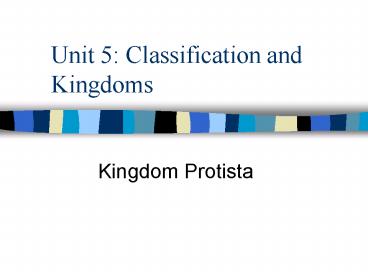Unit 5: Classification and Kingdoms PowerPoint PPT Presentation
1 / 23
Title: Unit 5: Classification and Kingdoms
1
Unit 5 Classification and Kingdoms
- Kingdom Protista
2
Kingdom Protista
- All are Eukaryotic
- Classified based on how they obtain nutrition
- Animal-like Protists are heterotrophic.
- Plant-like Protists are photoautotrophic.
- Fungus-like Protists are decomposers or parasites.
3
4 Phyla of Animal-like Protists.
- 4 Phyla classified by movement
- Zoomastigina (Zooflagellates)
- Sarcodina / Rhizopoda (Sarcodines)
- Ciliaphora (Ciliates)
- Sporozoa (Sporozoans)
4
I. Animal-Like Protists (Protozoans)
- Zooflagellates
- use flagella to move
- Absorb food through their cell membranes
- Most live in lakes and streams (some live in the
bodies of other organisms) - Reproduce asexually ? binary fission, (some have
a sexual life cycle)
5
Animal-like Protists (continued)
- Sarcodines (Rhizopoda)
- -Includes Amoebas
- - have food vacuoles for storage
- -reproduction via binary fission (asexual)
- - move by extensions of cytoplasm ?
- pseudopodia
6
(No Transcript)
7
I. Animal-Like Protists (Protozoans)
- Ciliaphora
- -use cilia (hair-like projections) to move,
feed, and sense their surrounding environment - - complex organelles include macronuclei,
micronuclei, contractile vacuoles (gets rid of
excess water) - Example Paramecium
8
Ciliate Reproduction
- Ciliates can be found in fresh and salt water
- Under most conditions, ciliates reproduce
asexually by mitosis and binary fission - However, when placed under stress, cilia may
engage in conjugation (sexual) - During conjugation, 2 cilia attach themselves to
each other and exchange genetic information
9
Animal-like Protists (continued)
- Sporozoa
- - sessile ?do not move
- - parasites- Sporozoa reproduce with
sporozoites (cells that result from multiple
fission and replicate within a hosts liver) - Ex. Plasmodium causes malaria and Trypanosoma
causes African Sleeping Sickness
10
II. Plant-Like Protists (Photoautrophic)
- Two Categories
- Unicellular Algae ? 4 phyla types
- Euglenophyta (Euglenophytes)
- Phynophyta (Dinoflagellates)
- Chrysophyta (Chrysophytes)
- Bacillaniophyta (Diatoms)
- Multicellular Algae ? 3phyla types
- Common plant Algae
11
II. Plant-Like Protists (Algae)
- Unicellular Examples
- 1) Euglenophytes 2 flagella for movement.
Example Euglena - 2) Dinoflagellates Most complete
photosynthesis you may have a population
explosion (algal bloom), which contaminates
seawater and organisms living there.
12
Red Tides
- Great blooms of the dinoflagellates have occurred
in recent years on the east coast - These blooms are known as red tides
- These species release a potentially harmful toxin
that infect certain shellfish - Eating these infected shellfish can be harmful or
fatal
13
Plant-like Protists (Unicellular Algae)
- Diatoms beautiful, silicon-rich cell walls
used as an abrasive agent in many products - Toothpaste
- Glass Making
- Pool filters
14
Plant-like Protists (Unicellular Algae)
- 4) Chrysophytes
- - a diverse group of plantlike protists that
have gold-colored chloroplasts - Sessile ? but have a flagella to assist in
movement during harsh conditions - Includes yellow-green algae and golden-brown
algae - Reproduction can be sexual or asexual
15
Plant-like Protists (Multicellular Algae)
- Multicellular Examples
- Red Algae (Rhodophyta)
- Brown Algae (Phaeophyta)
- Green Algae (Chlorophyta)
- Can be multicellular (Ulva), Colonial (Volvox),
or unicellular (Chlamydomonas).
16
Red Algae
Chondrus crispus (Irish moss)
17
Brown Algae
Giant kelp
18
Green Algae most abundant type of algae on
earth!!!
Chlamhydomonas unicellular green algae
Volvox colonial green algae
Ulva multicellular green algae
19
What are Plant-Like Protists Used For?
- Phytoplankton small, photosynthetic organisms
on the surface of the ocean Do about ½ of all
photosynthesis on planet Major oxygen producers
- Algae Phytoplankton are known as the grass of
the sea for many animals.
20
Human Uses of Algae
- Sushi rolls
- Ice creams
- Salad dressings
- Syrup
- Candy bars
- Plastics
- Waxes
- Deodorants
- Paints
21
III. Fungus-Like Protists
- Heterotrophs that decompose dead/decaying organic
matter and absorb nutrients. - Two Types Slime Molds Water Molds
22
III. Fungus-Like Protists
- Slime Molds
- Cellular Slime Molds
- Individual cells remain distinct throughout life
- Single cells migrate to one uniform colony
- Colony produces a fruiting body with spores
- Plasmodial Slime Molds (Ascellular)
- Single-celled with many nuclei (can be several
meters long) - Produces sporangia which releases spores.
23
III. Fungus-Like Protists
- Water Molds
- White, fuzzy organisms that grow on dead organic
matter in water and are plant parasites. - The water mold Phytophthora infestans caused the
Irish Potato Famine of 1845.

